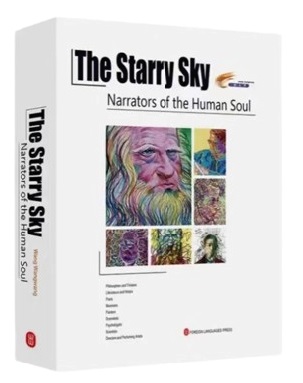
The Starry Sky: Narrators of the Human Soul
Author: Wang Wangwang
Price: RMB 168
Hardcover, 331 pages
Published by Foreign Languages Press
The Starry Sky: Narrators of the Human Soul is a book of masterful portraits that capture the essence of humanism. In nine chapters, the author paints, pop art-style, portraits of renowned philosophers, thinkers, writers, poets, musicians, painters, psychologists, scientists, directors, and performing artists from the West and the East who have transformed human history at some point in different ways. In a visual narrative, the book presents a multi-dimensional journey through the legacy of human civilization.
The author himself is a painter, graphic designer, and poet. A graduate from the Academy of Arts & Design, Tsinghua University, Wang is the visual director of the Art News of China, and project professor at the School of Urban Design of the Central Academy of Fine Arts. He is also a representative figure of Chinese avant-garde art, holding that art should be innovatory, exploring new forms of expression.
“Wang’s portrait art is creative in a unique and powerful way. As a mature artist, he has the consummate skills that allow him to traverse the complex and diversified worlds of art and different means of expression with ease, presenting the artistic reality in the fashion style of German composer Johann Sebastian Bach’s (1685-1750) polyphony and multi-dimensionality,” Jidi Majia, vice chair of the ninth national congress of the Chinese Writers’ Association and a poet with international influence, wrote in the foreword.
Wang’s creations are a kind of conceptual art that goes beyond the boundaries of different artistic paradigms. This kind of art draws attention to some stellar moments of humankind, like the work of Austrian writer Stefan Zweig (1881-1942), especially his famous book Decisive Moments in History: Twelve Historical Miniatures.
The book opens with the portrait of Laozi. The Chinese philosopher of the Spring and Autumn Period (770-476 B.C.) and founder of Taoism is painted, with his famous words in Tao Te Ching, “The Dao that can be trodden is not the enduring and unchanging Dao. The name that can be named is not the enduring and unchanging name. (Conceived of as) having no name, it is the Originator of heaven and earth; (conceived of as) having a name, it is the Mother of all things.” Then comes Greek philosopher Plato (427-347 B.C.), the father of Platonism, and Wang quotes his words, “Human behavior flows three main sources: desire, emotion, and knowledge.” The quote encapsulates the essence of human nature, summarizing the driving forces behind our actions and decisions.
French writer Victor Hugo (1802-1885) and Chinese writer Eileen Chang (1920-1995) are portrayed in the second chapter. Hugo once wrote, “The widest in the world are the seas and oceans; wider than the seas and oceans are the skies. Still wider than the skies are our minds and spirits,” while Chang wrote, “In a lifetime we wait for all kinds of things, big and small, and gradually we forget what we are waiting for.”
Wang also includes Chinese masters such as the great poets Qu Yuan, Li Bai, and Du Fu, whose humanistic spirit finds an echo in Western literary figures such as Victor Hugo, Goethe, Ezra Pound, Paul Celan, Marcel Proust, and Franz Kafka. These images also suggest association with great thinkers like Nietzsche, Martin Heidegger, Arthur Schopenhauer, and John Locke.
The images of musicians such as Bach, Beethoven, Maurice Ravel, and Franz Liszt are interspersed with those of great thinkers and writers among others, bringing a melodic quality to the portrait series. Given Wang’s identity as an artist, there are of course images of celebrated artists such as Da Vinci, Picasso, and Van Gogh.
Wang is capable of placing these great souls in a space of contemplation, using various means of expression and different styles of artistic language. The means and materials he uses include marker pens, oil pastels, ink, and the computer. The author creates an artistic world that connects different languages of the world and the spirits of mankind, and breaks through the boundaries of time, space, and art. It enables him to connect important thinkers, writers, artists, and other greats of human civilization to form a world of artistic creativity.
The world of art Wang presents is profound and boundless, going beyond the boundaries of humanism.